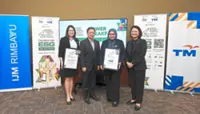fast-fashion garment in landfill, surrounded by discarded packaging and other waste, created with generative ai. Photo: 123rf.com
THE fashion industry is one of the most resource-intensive sectors, significantly contributing to environmental degradation through greenhouse gas emissions, wastewater generation, and solid waste.
According to the UN Environment Programme (UNEP), it is the second-largest consumer of water and accounts for 2% to 8% of global carbon emissions.
In Malaysia, the issue is intensifying with the rise of fast fashion, leading to increased textile waste and unsustainable production practices. As awareness of the environmental and social impacts of consumption grows, the circular economy model has gained momentum as a solution, aiming to eliminate waste, extend product lifecycles, and promote greater sustainability.
Malaysia faces significant challenges related to fashion waste. In 2021, fabric waste accounted for 31% (or 432,901 metric tonnes) of the country’s total waste, according to SWCorp and KlothCares.
The production of textiles places immense pressure on natural resources, with cotton farming requiring vast amounts of water and dyeing processes using toxic chemicals. Additionally, Malaysia’s waste management infrastructure is not fully equipped to handle the growing volumes of textile waste, resulting in most of it being sent to landfills, which contributes to further pollution.
Unlocking sustainable potentialThe shift towards a circular economy in Malaysia’s fashion industry opens up several promising opportunities. One such opportunity is the growing demand for eco-friendly and ethically produced clothing. Local designers and manufacturers can capitalise on this trend by adopting sustainable practices, such as using organic materials and implementing dyeing techniques that minimise water and chemical use.
Additionally, there is a rising interest in textile recycling, with startups in Malaysia developing innovative solutions for sorting and repurposing used clothing, thus helping to reduce waste and create new resources from discarded textiles.
Another promising area is the expansion of second-hand and resale markets. Thrift stores and online platforms for clothing swaps are gaining popularity, providing a sustainable alternative to fast fashion by extending the lifespan of garments and reducing the demand for new products.
Furthermore, prioritising local production offers significant environmental benefits by minimising the carbon footprint associated with transportation and promoting “Made in Malaysia” products. This not only supports local businesses but also contributes to the reduction of emissions, making it a key strategy for creating a more sustainable fashion industry.
Conquering obstaclesThe transition to a circular economy in Malaysia’s fashion industry faces several challenges that need to be addressed. One of the key obstacles is the prevailing fast fashion culture, which prioritises low-cost, disposable clothing. This mindset remains a significant barrier to sustainability, and changing it requires widespread education on the value of durability and environmentally conscious consumption. Encouraging consumers to choose quality over quantity is essential to shift the market towards more sustainable practices.
Malaysia’s textile waste management infrastructure is still underdeveloped, making efficient recycling systems difficult to implement. Establishing effective recycling solutions requires substantial investments and clear policies to ensure long-term success.
Another challenge lies in the cost of sustainable materials, which are often more expensive to produce. This price difference creates difficulties for small businesses trying to compete with larger mass-market retailers that prioritise low prices, making it harder for sustainable fashion to gain a foothold in the mainstream market.
Impactful initiatives Despite the challenges, several successful initiatives in Malaysia are driving the shift toward sustainable fashion and circular economy practices. One notable example is the rise of sustainable fashion brands like Batik Boutique and Kualesa.
Batik Boutique combines eco-friendly practices with traditional batik techniques to create handmade products, empowering local artisans while reducing environmental impact. Similarly, Kualesa promotes bamboo-based apparel, which is known for its comfort, durability, and minimal environmental footprint.
In the realm of upcycling, companies like Kanoe and Biji-Biji Initiative are transforming discarded materials into higher-value products. Kanoe upcycles fabrics into handmade clothing, while Biji-Biji repurposes materials such as seat belts and textiles to create innovative products that reduce waste and promote creative reuse.
Recycling initiatives are also gaining traction in Malaysia. Fashion e-commerce platform Zalora has launched programmes encouraging customers to donate unwanted clothes for recycling. Meanwhile, global retailers like H&M and Uniqlo are running garment collection programmes – H&M’s Garment Collection Program and Uniqlo’s Re.Uniqlo initiative – both of which collect used clothing for recycling or redistribution.
The demand for second-hand fashion is also on the rise, with online platforms like Carousell and Shopee gaining popularity as consumers seek affordable and sustainable alternatives to fast fashion. Local thrift stores are thriving as well, offering more options for customers looking to reduce their environmental impact through conscious consumption.
Partnership fosters progressPromoting circular practices in Malaysia’s fashion industry requires a collaborative effort from the government, businesses, and consumers. The government can make a significant impact by implementing policies such as tax incentives for sustainable practices, funding recycling programmes, and developing infrastructure for textile waste management.
Additionally, government procurement policies can prioritise sustainable fashion, setting an example for the industry.
Fashion businesses also have a crucial role to play by adopting sustainable practices throughout their supply chains, including sourcing eco-friendly materials and designing products for longevity and recyclability. Embracing circular business models, such as clothing rental or repair services, can further promote sustainability.
Consumers, too, can drive change by supporting brands committed to sustainability, purchasing second-hand items, and taking better care of their clothes. Educating consumers on the environmental impact of their purchasing choices is essential for fostering responsible consumption and advancing the circular economy.
Transitioning to a circular fashion economy in Malaysia presents an opportunity to reduce environmental impact, conserve resources, and create a sustainable fashion industry. By addressing challenges like waste, overproduction, and unsustainable consumption, Malaysia can set an example for other nations in South-East Asia. Collaboration between the government, businesses, and consumers will be key to shifting towards sustainability and building a more resilient, circular economy for the future.






